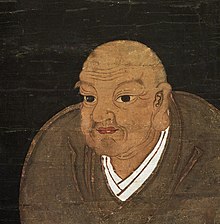Phật giáo Nichiren
| Một phần của loạt bài về |
| Phật giáo Nhật Bản |
|---|
 |
|
Kinh điển
|
Phật giáo Nichiren (日蓮仏教, âm Hán-Việt: Nhật Liên Phật giáo) là một tông phái của Phật giáo Đại thừa dựa trên giáo huấn của Đại sư Nichiren (1222-1282), một vị cao tăng Nhật Bản của thế kỷ 13. Ông thuộc ngành Phật giáo Kamakura.
Cơ bản của tông phái này dựa trên trước tác và kinh điển do thiền sư Nichiren truyền dạy.[1][2][3] Ngoài ra Liên Hoa Kinh cũng là phần cơ yếu. Bộ kinh này dạy rằng mọi người đều có Phật tánh từ bé, ai phát huy được thì giác ngộ nhãn tiền. Đặc biệt là Nichiren chủ trương năng động khi đối phó các tôn giáo khác.

Giáo lý của tông phái Nichiren sang thế kỷ 20 được dùng làm nền tảng của giáo hội Soka Gakkai International và theo đó được truyền bá không những ở Nhật Bản mà sang các nước khác. Thiền sư Nichiren có người thì cho là giác nhân hay bồ tát, nhưng cũng có người thì xem ông như một vị Phật vị lai.[4][5][6]
Ngoài giáo hội Soka Gakkai/Soka Gakkai International, tông phái Nichiren cũng phát sinh ra những giáo phái nhỏ rải rắc từ Hoa Kỳ sang Brasil, Âu châu, Hàn Quốc và Đông Nam Á như Nichiren Shu và Nichiren Shoshu.

Tham khảo
[sửa | sửa mã nguồn]- ^ Iida, Shotaro (1987). “Chapter 5: 700 Years After Nichiren”. Trong Nicholls, William (biên tập). Modernity and Religion. Wilfrid Laurier University Press. tr. 98–105. ISBN 0-88920-154-4.
- ^ Arai, Nissatsu (1893). Outlines of the Doctrine of the Nichiren Sect, Submitted to the Parliament of the World's Religions. Tokyo, Japan: Central Office of the Nichiren Sect. tr. vi.
One who wants to know how high was his virtue, how profound and extensive was his learning, how heroic and grand was his character, and how gigantic and epoch-making was his mission, needs only to read his works.
- ^ http://www.totetu.org/assets/media/paper/k018_258.pdf
- ^ Hein, Patrick (2014). The Goddess and the Dragon: A Study on Identity Strength and Psychosocial Resilience in Japan. Cambridge Scholars Publishing. tr. 67. ISBN 9781443868723.
- ^ Ellwood, Robert S.; Csikszentmihalyi, Mark A. (2003). “Chapter 12: East Asian Religions in Today's America”. Trong Neusner, Jacob (biên tập). World Religions in America: An Introduction. Westminster John Knox Press. tr. 225. ISBN 9780664224752.
- ^ Cornille, Catherine (1998). “Canon formation in new religious movements: The case of the Japanese new religions”. Trong Debeek, A. Van; Van der Toorn, Karel (biên tập). Canonization and Decanonization. Brill. tr. 284. ISBN 9004112464.
Text is available under the CC BY-SA 4.0 license; additional terms may apply.
Images, videos and audio are available under their respective licenses.
